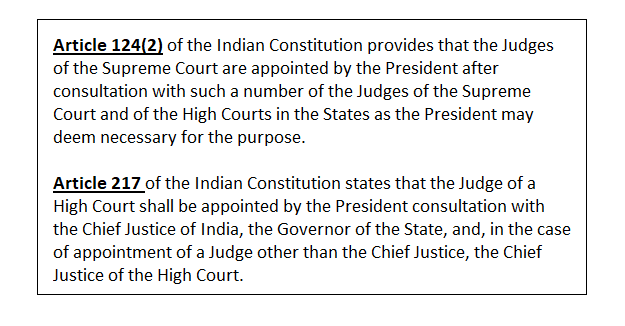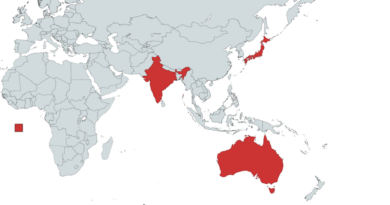Collegium System for the Appointment of Judges
Context:
Recently, the Supreme Court Collegium has recommended appointing Justice Munishwar Nath Bhandari as Chief Justice of Madras High Court.
What is the Collegium System?
- It is a novel mechanism devised to ensure a democratic system of appointment and transfer of judges
- It came into existence through Second and Third Judges Case judgments.
- Please note: There is no such law or constitutional provision that mentions or defines the collegium system.
- It is headed by the CJI and comprises 4 other senior-most judges of the court.
- An HC collegium is led by its Chief Justice and four other senior-most judges of that court.
- NJAC was thought of as a replacement of the Collegium System but it was invalidated by the Supreme Court.
- Evolution:
- The collegium system has its genesis in a series of Supreme Court judgments called the ‘Judges Cases’.
- FIRST JUDGES CASE: In S P Gupta Vs Union of India, 1981, the Supreme Court judgment held that consultation does not mean concurrence and it only implies an exchange of views.
- SECOND JUDGES CASE: In The Supreme Court Advocates-on-Record Association Vs Union of India, 1993, a nine-judge Constitution Bench overruled the decision and devised a specific procedure called ‘Collegium System’ for the appointment and transfer of judges in the higher judiciary.
- The majority verdict in the Second Judges Case accorded primacy to the CJI in matters of appointment and transfers while also ruling that the term “consultation” would not diminish the primary role of the CJI in judicial appointments.
- The role of the CJI is primal in nature because this being a topic within the judicial family, the executive cannot have an equal say in the matter.
- THIRD JUDGES CASE: In the Third Judges case (1998), the Court opined that the consultation process to be adopted by the Chief Justice of India requires ‘consultation of plurality judges’.
- The sole opinion of the CJI does not constitute the consultation process.
- He should consult a collegium of four senior-most judges of the Supreme Court and even if two judges give an adverse opinion, he should not send the recommendation to the government.
- The court held that the recommendation made by the chief justice of India without complying with the norms and requirements of the consultation process is not binding on the government.
What are constitutional provisions backing it?
- Article 124(2): The Judges of the Supreme Court are appointed by the President after consultation with such a number of the Judges of the Supreme Court and of the High Courts in the States as the President may deem necessary for the purpose.
- Article 217: The Judge of a High Court shall be appointed by the President in consultation with the CJI and the State Governor, and, in the case of appointment of a Judge other than the Chief Justice, the Chief Justice of the High Court.

What are the criticisms against the collegium?
- Unconstitutional and autocratic: ‘Collegium’ is nowhere mentioned in the Constitution and has been evolved by the judiciary itself for retaining the power to select judges by itself.
- Undemocratic: Selection of judges by collegium is undemocratic since judges are not elected by the people and are not accountable to the people or to anyone else.
- Non-transparency and opaque: (No official procedure for selection + lack of a written manual for functioning + selective publication of records of meetings+ no eligibility criteria of judges) = bring opacity in collegium’s functioning.
- Promotes nepotism: Sons and nephews of previous judges or senior lawyers tend to be popular choices for judicial roles. Thus it encourages mediocrity in the judiciary by excluding talented ones.
- Inefficient: Collegium has not been able to prevent the increasing cases of vacancies of judges and cases in courts.
- Ignores SC’s own guidelines: The recent supersession in appointment is inconsistent with the view of the Supreme Court in the Second Judge’s case, 1993, where it laid that:
- Seniority amongst Judges in their High Courts and on all India basis is significant and should be given due consideration while making appointments from amongst High Court Judges to the Supreme Court.
- Unless there is any strong reason to justify a departure, that order of seniority must be maintained between them while making their appointment to the Supreme Court.
- Against established conventions: The convention of ‘seniority’ has long been held as the procedure for appointments but ‘supersession’ ignores and abdicates this convention, creating space for subjectivity and individual bias in appointments.
- No reforms made after the fourth judges case: After striking down the NJAC, the court did nothing to amend the NJAC Act or add safeguards to it that would have made it constitutionally valid. Instead, the court reverted to the old Collegium-based appointments mechanism.
Efforts have been made to address concerns
- The Government appointed Justice M N Venkatachaliah Commission which favoured the change and prescribed a National Judicial Appointments Commission (NJAC) consisting of the
- CJI and two senior-most judges
- The Law Minister
- An eminent person from the public, to be chosen by the President in consultation with the CJI.
- In 2014 Government brought the 99th Constitutional Amendment Act, the National Judicial Commission Act (NJAC) to replace the collegium system for the appointment of judges.
- In 2015, a five-judge Constitution Bench declared them unconstitutional on the ground that they posed a threat to the independence of the judiciary.
- Bench declared that judges’ appointments shall continue to be made by the collegium system in which the CJI will have “the last word”.
Way forward:
- It is time to think of a permanent, independent body to institutionalize the process with adequate safeguards to preserve the judiciary’s independence guaranteeing judicial primacy but not judicial exclusivity. It should ensure independence, reflect diversity, and demonstrate professional competence and integrity.
- Unless there is any strong reason to justify a departure, that order of seniority must be maintained between them while making their appointment to the Supreme Court
- Instead of selecting the number of judges required against a certain number of vacancies, the collegium must provide a panel of possible names to the President to appoint in order of preference and other valid criteria.
- A written manual should be released by the Supreme Court which should be followed during appointments and records of all meeting should be in the public domain in order to ensure transparency and rule-based process.
National Judicial Appointment Commission
- The government moved 99th Constitutional Amendment Bill to establish National Judicial Appointment Commission
- It was envisaged as an independent commission to appoint and transfer judges of High Court and appoint judges of Supreme Court of India.
- It was composed of three senior judges, two eminent outsiders and the Law Minister.
- The constitutional amendment was passed by Parliament and was ratified by 20 states.
- However, before it was notified, it was challenged in Supreme Court as an attempt by government to interfere with the independence of the judiciary.
- The motive behind creation of NJAC was to bring reforms in appointment process of Indian higher judiciary
Source: Indian Express
Related article: Appointment of Judges



